Products You May Like
My dad was on the phone. The ski season was looming and he wanted me to know that he’d bought a new pair of skis. “But didn’t you just buy a new pair of skis last year?” I asked. We’re a ski family, but a relatively thrifty one. I had skied on dead-straight Atomic ARC 205s well into the 2000s. Dad, who literally grew up at Sugarloaf as the son of Sugarloaf Inn proprietors, had been even more skeptical of the shaped-ski revolution.
“Yeah, but I needed some race skis. Those all-mountain skis weren’t cutting it.” He’d bought a pair of Atomic Redster GS skis, the same skis Mikaela Shiffrin uses.
This year, as he turned 70, he was going to get serious about his Racing with the Moon league team at Shawnee Peak, a 1,900-foot family mountain on the banks of Moose Pond in Bridgton, Maine. He and I had taught my now-teenage kids to ski there, roughly 45 minutes from my house.
Dad was unsatisfied with his start in the league the previous year, in early 2020. He joined at the urging of Mark Russell, a member of his dinner club, grabbing a spot on one of a trio of teams sponsored by Tak Sato, co-owner with his wife Susan of the Yosaku sushi restaurant that is a mainstay of the Portland, Maine, dining scene. Russell had been skiing with Yosaku for a half-dozen years and came to understand that Dad—usually the best skier on any trail and a former skimeister at the University of Vermont in the early 1970s—might enjoy it.
And be an asset.
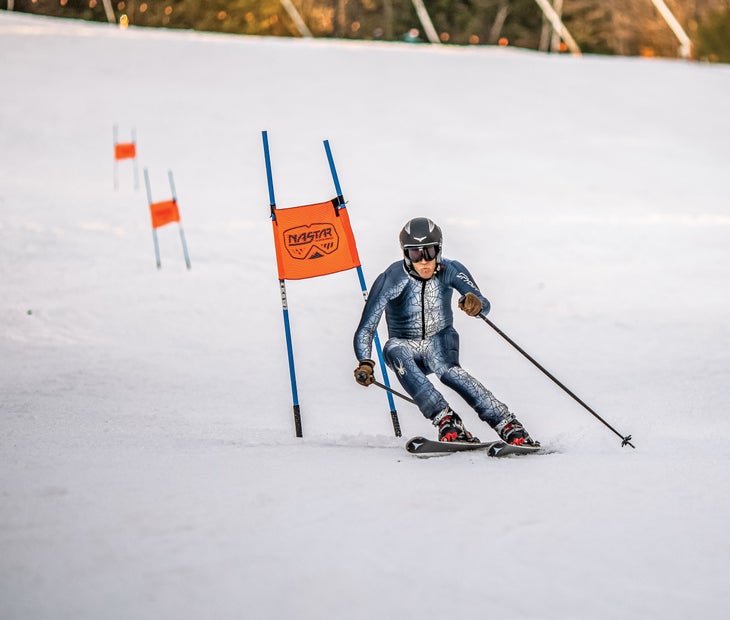
Fast-forward to 2021 and—Covid-be-damned—Dad found himself captaining Yosaku’s competitive Yamato team, having been handed the reins from Heidi Andrews after amassing the third-most points of any Yosaku racer last year. Andrews had a new job and couldn’t make the every-Wednesday-night commitment. That suited my father, the president of his condo association and someone who coached my sister’s youth soccer squads to championship games in Massachusetts’ cutthroat atmosphere, just fine.
Of course, Dad’s good, but he’s not that good. His point total is the result of NASTAR’s ingenious method of handicapping. As a NASTAR-participating league, Moonlight Shawnee racers not only get a chance to compare themselves with competitors of all shapes and sizes across the country, but they also get to compete in one of the most meritorious racing systems ever devised in any sport.
Everyone in any given race earns points based on how their results compare to the “pacesetter,” with magnifiers added for various factors—age, riding a snowboard, etc. You get one point for showing up. Beyond that, you earn what your relative performance deserves.
Get Race Ready: 10 Frontside Skis That Rail on Hardpack and Are Made for Eastern Skiers
After week one this year, it became clear that Kamden Burke would be the pacesetter and that Dad needed to get him on the Yamato team.
Longtime readers of SKI may well remember Burke. He first appeared in these pages in 1991, a featured NASTAR racer at the age of 2 with a handicap of 347 (sponsored by lite beer and Coca-
Cola, no less). Since then, he went on to race at the highest levels, winning International Ski Federation (FIS)-sanctioned races in GS and downhill at Sugarloaf in 2006, two GS races at Sugarbush in 2009, and amassing 11 total podiums through 2012 before a broken leg knocked him out of the sport, seemingly for good.
He couldn’t get his leg in a ski boot without pain, let alone race against the world’s best.
Now, however, in the weird reality that Covid created, he found himself returned to his home state, not far from the town he grew up in, with some time on his hands. His sister, Adora, also a talented racer, had worked at Yosaku and was the one who, some 15 years ago, talked Sato into sponsoring a team at Shawnee in the first place.
She encouraged her brother, now 33 years old: Why not get back on the hill Wednesday nights?
“Tak and my sister are some kind of soulmates,” Burke says. “When I told her I was thinking about skiing again, she said, ‘You have to call Tak.’ When I got on the phone with him, he said, ‘Are you a good skier like Adora?’ I said, I’m not sure. I haven’t skied in so long.”
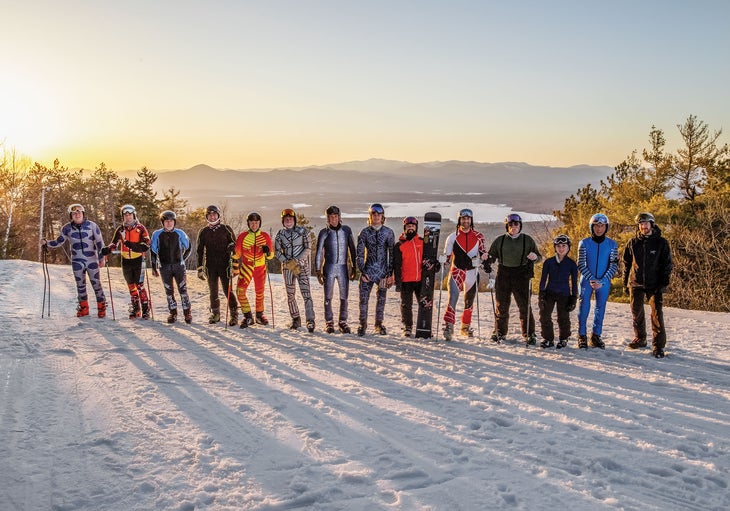 It’s the eccentric characters that make Shawnee Peak’s beer league racing scene so unique. Photo: Chris Bennett
It’s the eccentric characters that make Shawnee Peak’s beer league racing scene so unique. Photo: Chris BennettAt the last minute, Burke recruited Rory Kelly, another lapsed world-class racer with 10 top-10 FIS finishes under his belt and a tour atop the Colby College race team, to join him back on the hill. Kelly also found himself in Maine thanks to the Covid diaspora, still working as a DC law-firm investigator from a home office.
The two of them decided to enter a team of their own at Shawnee, but couldn’t get anyone else to join them, and so raced week one of the 2021 season as a team of two. The Lost Boys, as they called themselves, managed to finish fourth out of 10 seven-person teams, anyway.
“My first day back on snow was really emotional,” Burke says, “because my whole life was skiing … and Shawnee, there’s a lot of sentiment there.” It had been his home hill, where he spent time on the race team as a kid before getting his full ride at the ski-crazy Gould Academy, a prep school in nearby Bethel.
Now he was back racing. Even if it was against a collection of 70-year-olds. And was that guy in jeans?
Regardless, Burke put up the best time of the day: 23.88 seconds. Kelly was second. Their performance did not go unnoticed. They were quickly absorbed into the Yosaku fold.
“Tak is a cultivator of talent,” says Tom Morse, another Yosaku racer and a longtime friend of Sato’s. What you have to understand about the 75-year-old Sato is that he is no garden-variety weekend warrior. Coming out of the prestigious Waseda University in Japan in the late 1960s, he was twice on their national championship hockey team and played against the Japanese Olympic team as part of their run-up to the Games.
“And he won’t want you to say this,” says Morse, “but he was a very highly respected baseball pitcher and played in their high school World Series. It’s very big.”
“I think the knee-jerk thing to say would be that Tak loves competition,” Morse continues thoughtfully, “and he loves the thrill of victory, but I think he really just likes the fun of it, the camaraderie, and having everybody on the team, and I think it’s really just to get together and have fun.”
Ellie Sato, his daughter, isn’t so sure.
A professional dancer with Alvin Ailey, she also found herself back in Maine this year thanks to the pandemic. There weren’t many dance performances going on, that’s for sure. Her New York City home was turning into a ghost town. So, why not come home, work in the restaurant, and race on Wednesdays with dad?
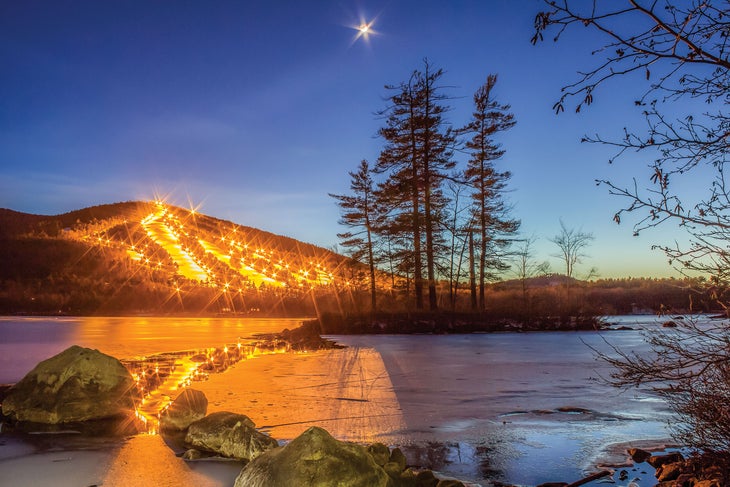
“I’ve always found it interesting, the reason I got into ski racing to begin with,” she says when I catch up with her. “It’s a classic father-daughter competition story.”
Sato had started his team while Ellie was in high school, something to do along with tennis and hockey to keep active, but now Ellie was at Fordham University, taking dance classes.
“I don’t ski regularly at all, but I was in peak fitness—peak fitness,” and here she slips into the impersonation she tends to do of her father, Japanese-accented masculine English, “So we want to see if Yoko beat me now that she dancing all the time.”
Up they went to Shawnee together. “I think he beat me that first day, but the years after that, I’d beat him by, like, one-tenth of a second.” Sato would pay Ellie’s entire league fee each of the last handful of years, just so she could get her time officially recorded as part of the race league in one race, back from college or for the holidays, for posterity. “I don’t think he’s ever, really, truly beaten me. But it’s always close. So close. He just thinks if he’s a little bit faster, he’d beat me.”
This year, though, she ran the whole slate.
“Skiing every Wednesday, that’s when I started paying more attention to the stats,” she says, “trying to get better, talking to Kamden Burke, talking to your dad, talking to Art Cunningham … and that’s when I started beating him by 2-3 seconds, where he has no chance.”
Yes, Art Cunningham, head of the rival Ancient Artifacts, the team that had won the Wednesday night league at Shawnee Peak for the past 11 years (or was it nine … records are hazy) leading up to this one, who showed up to the hill with custom-made jackets listing recent annual wins on the left lapel.
Yes, Art Cunningham, the top-rated 75-year-old in all of U.S. NASTAR racing.
Yes, Art Cunningham, the guy who caused my father no end of consternation when he just couldn’t beat him. Basically, he’s the reason Dad bought the new skis.
“He’s five years older than me!” Dad says. “I should be able to beat him.”
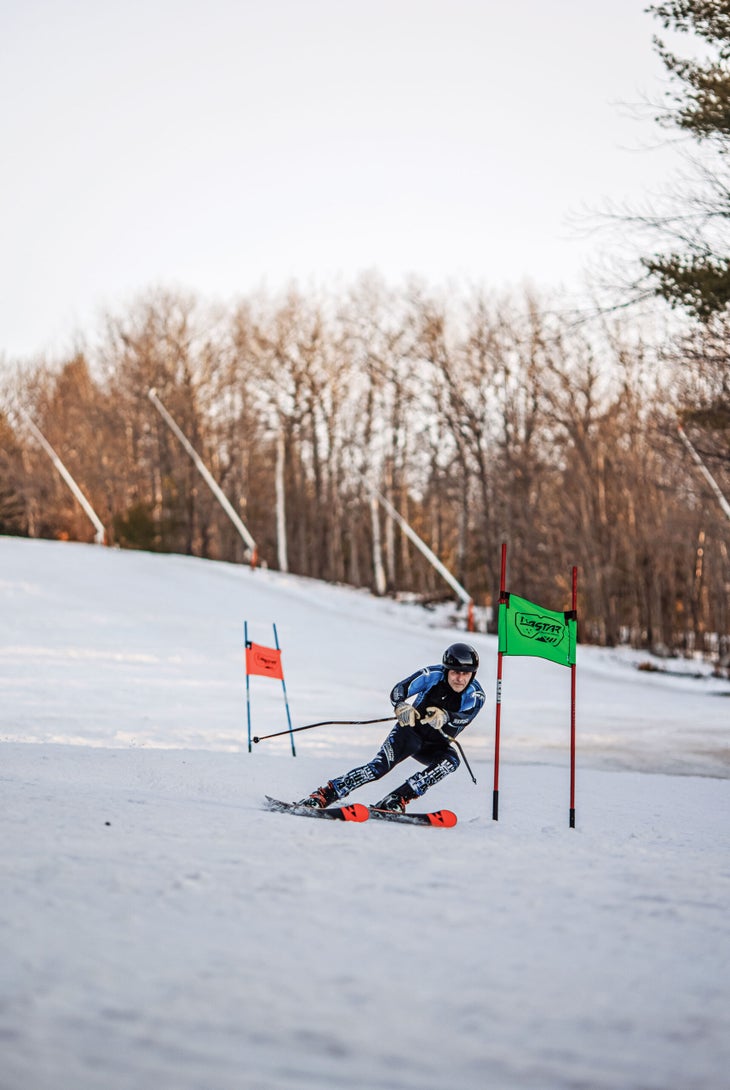 Longtime speedster Art Cunningham attempts to stave off the competition. Photo: Chris Bennett
Longtime speedster Art Cunningham attempts to stave off the competition. Photo: Chris BennettGrowing up in the mill town of Rumford, Maine, Cunningham got started at a place called Scotty’s—“a farmer in the area who let the local ski club use his mountain,” Cunningham explains when I confess I’ve never heard of it, “he had cattle and stuff”—then went to the University of Colorado to ski the Nordic events, particularly jumping, before transferring and taking Western State College to second place in all of Division 1, winning a personal Nordic-combined national title.
“It was a weak year,” Cunningham says, “but that’s okay.”
He was invited, too, to the 1968 Winter Olympic trials but didn’t have the money. “I was in college, and if you made it, the expenses were paid, but I didn’t have the money to get there,” he says. “It’s one of those stories that a lot of guys have. I was good enough, but it just didn’t break right.”
So, instead of watching Jean-Claude Killy win three golds on his home turf in France, Cunningham got a job teaching high school, hitting local ski carnivals in places like Brattleboro, Vt., Berlin, N.H., and Andover, Maine, into his 30s.
“Ski jumping was very popular in those days,” he says.
Then, maybe 25 or 30 years ago, some guys at work (he’d moved into manufacturing) talked him into the Shawnee corporate ski league. “It wasn’t as easy as ski jumping,” he jokes. “In ski jumping you don’t have to turn.” Maybe 12 years later, he convinced everyone to call the team the Ancient Artifacts.
“We were all older people and we started doing well,” he reasons. “So we went with Ancient Artifacts and they sponsored us anyway. So now we drive people crazy with being the Ancient Artifacts.” And winning.
But Cunningham says he’s never been all that competitive about it. “If they had someone show up who didn’t have a team, I’d always volunteer to take them,” he says. “I don’t care how you ski, just join the team and show up. That’s it. Go fast, slow, whatever. Just come. And we’ve had people who’d snow plow through the course and that was fine. We didn’t go in with the idea that we’d win, we just went. And people kept doing it, and they’ve returned year after year. It’s a good time. You get to meet people like Tak. It’s a very friendly group.”
“If it’s bad weather, you go home,” he says, matter of factly. “If not, you sit around afterward and have a beer and nachos and chicken wings. Just talk.”
Part of that talk is helping others be as fast as they can be. For Tom Morse, “Art saw the skis I was skiing and said, ‘You can’t do anything with those skis. I’ve got a pair of racing skis you can have for 100 bucks.” For Dad, Cunningham saw he could use a racing suit and sold him one he had lying around for $150.
The next week, Dad beat him for the first time. And he would eventually dethrone Ancient Artifacts, too.
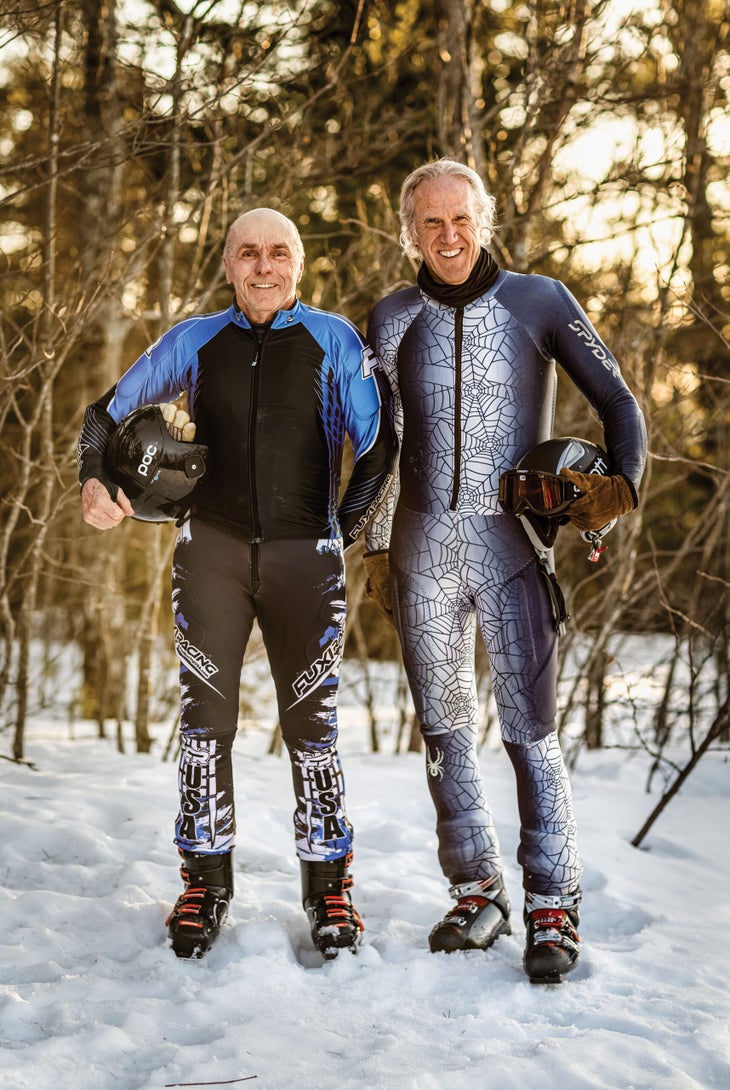
That was also thanks to Nate Soucy, in some ways the least likely Yamato team member. He’s a snowboarder, after all. But he is a former NorAm tour member who regularly posted top-20s in both the alpine and boarder-cross disciplines and recently took home wins in hybrid banked slalom races at Killington and in the Vermont Open. He regularly wins his age division up at Sugarloaf. And snowboarders get a great handicap.
Soucy had been a regular at Yosaku for years and knew Tak sponsored a ski team, “and I knew he was very competitive and joked with him once or twice about being on his ski team. He kind of laughed it off for about two years. And then Seth Wescott was eating at the restaurant and Tak told him there was a snowboarder who wanted to race.”
Soucy laughs: “Wescott vouched for me and the next time I was in, Tak was like, ‘Dude, you have to be on the team! What’s your email?’”
Yes, Maine is so small that Olympic gold medalists like Seth Wescott just eat at the local sushi joint and it’s not weird at all that Nate Soucy also happens to be the guy who’s been cutting my hair for the last 10 years or so, running his own high-end barbershop called Nathan Charles. There just aren’t that many people here.
“I love the challenge of being on one edge and going up against skiers,” Soucy says, calling me back, in between cuts. “I would go there to have a good time, but also with a chip on my shoulder.” He also realized the different course settings and the less-than-
immaculate surface conditions of a ski race with racers of all abilities like this made him a lot better at his craft.
“If I can survive that,” he says, “then technically I’m that much better when I go through a much smoother snowboard course. It’s almost like desensitizing me to regular snowboard racing.”
So, yeah, Dad was working with a bit of a stacked deck, moving Soucy onto the Yamato team after he saw the results of Week 1—“You have to finalize your roster by Week 2,” he explains of how he managed it—and consolidating firepower.
Yamato never lost another week and ended up winning the overall title quite handily. When my father posted the team photo to Facebook on the night of their final victory, I was pretty damn happy for him. Because they won, sure, but mostly because I knew Dad had found a group of people who were just like him, who loved competition and sport and never giving up and always trying to get faster. And who knew all of the competition and sport was mostly just a vehicle for enjoying the hell out of life on a New England ski hill.
Spotlight: Winning at the Next Level
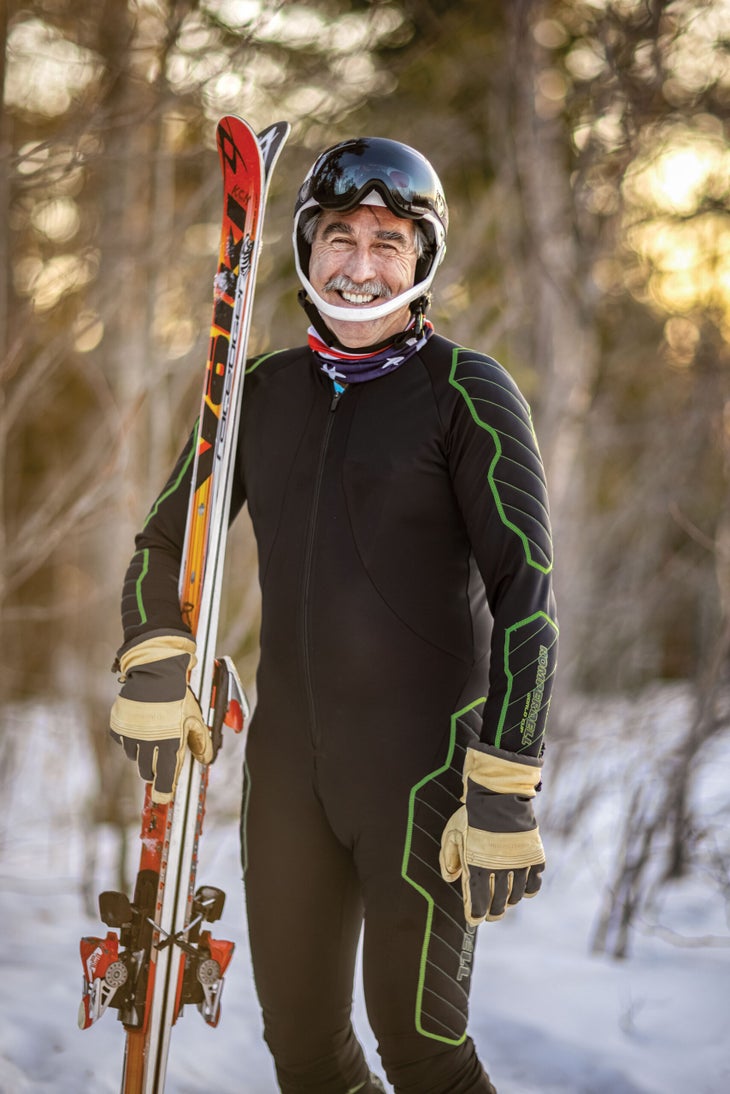
KC Hughes is no leading scorer for the Yosaku teams. He raced for the Musashi team that finished sixth overall this year. At 64, he brings a great handicap to the table, but he isn’t quite fast enough to score the big points. In NASTAR terms, he is a bronze skier. Good enough to medal, but not a top performer.
That doesn’t mean, however, he can’t still compete for a championship.
A few weeks after the final Racing with the Moon event, Hughes found himself at Snowmass, Colo. for the NASTAR Nationals. “Tak originally talked me into going,” he says afterward, “and then dropped out. He wanted to see his new grandson. I totally get it. Family comes first.”
With a second vaccine shot in his arm, he went anyway. He and his 19-year-old son had been at Breckenridge when everything shut down in 2020. It would be fitting to come out of the pandemic in Colorado again.
And what an opportunity. He got to meet and talk skiing with a couple of pacesetters you might recognize, like Olympians Laurenne Ross (nine seasons on the World Cup tour) and Paula Moltzan (you may have seen a little feature on her in these pages back in March). They “were very nice, very approachable, and gave great hints,” Hughes says.
Also Read: The U.S. Ski Teamer You Should Watch
Oh, and he won. He took home the gold medal in the Bronze Division, 60-64 age group. “Beat a couple of flatlanders,” he says, modestly. “Probably Covid and attrition due to age helped me win.” The next day, he moved up to try his hand at the Silver Division and finished fourth.
The whole experience was spectacular until his girlfriend broke her tibia in the slush 500 feet from the lodge, he reports. Such is skiing.
“Looking forward to racing again next year,” he says in parting. “You need to talk your Dad into going to Nationals next year with Art and Tak!”
